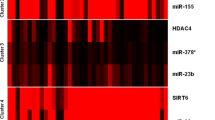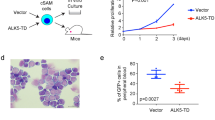Abstract
Histone deacetylase enzymes, confirmed to have important role in the pathogenesis of leukemia, are promising targets of epigenetic treatment. However, in acute myeloid leukemia, our knowledge on their expression levels is limited, and controversial data have been published about their potential oncogenic or tumorsuppressor properties in solid tumors. In our study, the expression levels of HDAC4 and SIRT6 were evaluated via Western blot analysis in 45 bone marrow samples (2 uninfiltrated and 43 concerned by different kinds of hematological malignancies), including 32 specimens obtained from patients with newly diagnosed AML. Significantly higher HDAC4 level was detected in case of FLT3-ITD mutation compared to the group of patients without carrying this mutation (p < 0.05). Compared to the non-infiltrated samples, the expression level of HDAC4 in AML M5 patients has been proved to be significantly higher (p < 0.05). Decreasing expression levels of both HDAC4 and SIRT6 were observed during the induction treatment of FAB M5 type AML. Strong correlation has been proved between the expression levels of HDAC4 and SIRT6 (r = 0.722 in full cohort and r = 0.794 in AML), that confirms the recently suggested cooperation between NAD+-independent and NAD+-dependent HDAC enzymes in leukemia.






Similar content being viewed by others
Abbreviations
- ALL:
-
Acute lymphoblastic leukemia
- AML:
-
Acute myeloid leukemia
- BCA:
-
Bicinchoninic acid assay
- BSA:
-
Bovine serum albumin
- CBP:
-
CREB-binding protein
- CLL:
-
Chronic lymphocytic leukemia
- FAB:
-
French-American-British Classification
- FDA:
-
Food and Drug Administration
- FLT3:
-
Fms-like tyrosine kinase 3
- GCN5:
-
General control of amino acid synthesis 5
- EDTA:
-
Ethylene-diamine-teraacetic acid
- ETO:
-
Eight twenty one
- HAT:
-
Histone acetyltransferase
- HDAC:
-
Histone deacetylase
- HCL:
-
Hairy cell leukemia
- HL:
-
Hodgkin lymphoma
- hMOF:
-
Human orthologue of the Drosophila melanogaster males absent on the first gene
- HMT:
-
Histone methyltransferase
- ITD:
-
Internal tandem duplication
- JAK:
-
Janus kinase
- MDS:
-
Myelodysplastic syndrome
- MLL:
-
Mixed lineage leukemia
- MPAL:
-
Mixed-phenotype acute leukemia
- NCOR:
-
Nuclear receptor co-repressor
- NPM1:
-
Nucleophosmin 1
- NuRD:
-
Nucleosome remodeling deacetylase
- PBX:
-
Pre-B-cell leukemia homeobox
- PCBP2:
-
Poly(C)-binding protein 2
- PRL3:
-
Phosphatase of regenerating liver cell 3
- qPCR:
-
Quantitative polymerase chain reaction
- RT:
-
Reverse transcription
- SAHA:
-
Suberoylannilide hydroxamic acid
- SDS:
-
Sodium dodecyl sulfate
- SIRT:
-
Sirtuin
- SMRT:
-
Silencing mediator of retinoid and thyroid hormone receptor
- STAT:
-
Signal transducers and activators of transcription
- TKD:
-
Tyrosine kinase domain
References
Haberland M, Montgomery RL, Olson EN (2009) The many roles of histone deacetylases in development and physiology: implications for disease and therapy. Nat Rev Genet 10:32–42
Linggi BE, Brandt SJ, Sun ZW, Hiebert SW (2005) Translating the histone code into leukemia. J Cell Biochem 96(5):938–950
Delcuve GP, Khan DH, Davie JR (2012) Roles of histone deacetylases in epigenetic regulation: emerging paradigms from studies with inhibitors. Clin Epigenetics 4(1):5
de Ruijter AJ, van Gennip AH, Caron HN, Kemp S, van Kuilenburg AB (2003) Histone deacetylases (HDACs): characterization of the classical HDAC family. Biochem J 370(Pt3):737–749
Marks PA (2010) Histone deacetylase inhibitors: a chemical genetics approach to understanding cellular functions. Biochim Biophys Acta 1799(10–12):717–725
Yang XJ, Seto E (2008) The Rpd3/Hda1 family of lysine deacetylases: from bacteria and yeast to mice and men. Nat Rev Mol Cell Biol 9(3):206–218
Verdin E, Dequiedt F, Kasler HG (2003) Class II histone deacetylases: versatile regulators. Trends Genet 19(5):286–293
Barneda-Zahonero B, Parra M (2012) Histone deacetylases and cancer. Mol Oncol 6(6):579–589
Bosch-Presegue L, Vaquero A (2011) The dual role of sirtuins in cancer. Genes Cancer 2(6):648–662
Saunders LR, Verdin E (2007) Sirtuins: critical regulators at the crossroads between cancer and aging. Oncogene 26(37):5489–5504
Liu H, Hu Q, D'Ercole AJ, Ye P (2009) Histone deacetylase regulates 11. Oligodendrocyte-specific gene expression and cell development in OL-1 oligodendroglia cells. Glia 57(1):1–12
Villagra A, Cheng F, Wang HW, Suarez I, Glozak M, Maurin M et al (2009) The histone deacetylase HDAC11 regulates the expression of interleukin 10 and immune tolerance. Nat Immunol 10(1):92–100
Smith KT, Workman JL (2009) Histone deacetylase inhibitors: anticancer compounds. Int J Biochem Cell Biol 41(1):21–25
Bantscheff M, Hopf C, Savitski MM, Dittmann A, Grandi P, Michon AM (2011) Chemoproteomics profiling of HDAC inhibitors reveals selective targeting of HDAC complexes. Nat Biotechnol 29(3):255–265
Khan O, La Thangue NB (2012) HDAC inhibitors in cancer biology: emerging mechanisms and clinical applications. Immunol Cell Biol 90(1):85–94
Witt O, Deubzer HE, Milde T, Oehme I (2009) HDAC family: what are the cancer relevant targets? Cancer Lett 277(1):8–21
Tabe Y, Jin L, Contractor R, Gold D, Ruvolo P, Radke S et al (2007) Novel role of HDAC inhibitors in AML1/ETO AML cells: activation of apoptosis and phagocytosis through induction of annexin A1. Cell Death Differ 14(8):1443–1456
Holmlund T, Lindberg MJ, Grander D, Wallberg AE (2013) GCN5 acetylates and regulates the stability of the oncoprotein E2A-PBX1 in acute lymphoblastic leukemia. Leukemia 27(3):578–585
Di Croce L (2005) Chromatin modifying activity of leukemia associated fusion proteins. Hum Mol Genet 14(Review Issue 1):R77–R84
Hackanson B, Rimmele L, Benkißer M, Abdelkarim M, Fliegauf M, Jung M et al (2012) HDAC6 as a target for antileukemic drugs in acute myeloid leukemia. Leuk Res 36(8):1055–1062
Novotny-Diermayr V, Hart S, Goh KC, Cheong A, Ong LC, Hentze H et al (2012) The oral HDAC inhibitor pracinostat (SB939) is efficacious and synergistic with the JAK2 inhibitor pacritinib(SB1518) in preclinical models of AML. Blood Cancer J 2(5):e69
Zhou L, Ruvolo VR, McQueen T, Chen W, Samudio IJ, Conneely O et al (2013) HDAC inhibition by SNDX-275 (Entinostat) restores expression of silenced leukemia-associated transcription factors Nur77 and Nor1 and of key pro-apoptotic proteins in AML. Leukemia 27(6):1358–1368
Tran HT, Kim HN, Lee IK, Nguyen-Pham TN, Ahn JS, Kim YK et al (2013) Improved therapeutic effect against leukemia by a combination of the histone methyltransferase inhibitor chaetocin and the histone deacetylase inhibitor trichostatin a. J Korean Med Sci 28(2):237–246
Cea M, Soncini D, Fruscione F, Raffaghello L, Garuti A, Emionite L et al (2011) Synergistic interactions between HDAC and Sirtuin inhibitors in human leukemia cells. PLoS ONE 6(7):e22739
Van Damme M, Crompot E, Meuleman N, Mineur P, Bron D, Lagneaux L et al (2012) HDAC isoenzyme expression is deregulated in chronic lymphocytic leukemia B-cells and has a complex prognostic significance. Epigenetics 7(12):1403–1412
Yu SL, Lee DC, Son JW, Park CG, Lee HY, Kang J (2013) Histone deacetylase 4 mediates SMAD family member 4 deacetylation and induces 5-fluorouracil resistance in breast cancer cells. Oncol Rep 30(3):1293–1300
Wilson AJ, Byun DS, Nasser S, Murray LB, Ayyanar K, Arango D et al (2008) HDAC4 promotes growth of colon cancer cells via repression of p21. Mol Biol Cell 19(10):4062–4075
Zhu L, Yang J, Zhao L, Yu X, Wang L, Wang F et al (2015) Expression of hMOF, but not HDAC4, is responsible for the global histone H4K16 acetylation in gastric carcinoma. Int J Oncol 46(6):2535–2545
Niegisch G, Knievel J, Koch A, Hader C, Fischer U, Albers P et al (2013) Changes in histone deacetylase (HDAC) expression patterns and activity of HDAC inhibitors in urothelial cancers. Urol Oncol 31(8):1770–1779
Gruhn B, Naumann T, Gruner D, Walther M, Wittig S, Becker S et al (2013) The expression of histone deacetylase 4 is associated with prednisone poor-response in childhood acute lymphoblastic leukemia. Leuk Res 37(10):1200–1207
Sebastián C, Zwaans BM, Silberman DM, Gymrek M, Goren A, Zhong L et al (2012) The histone deacetylase SIRT6 is a tumor suppressor that controls cancer metabolism. Cell 151(6):1185–1199
Khongkow M, Olmos Y, Gong C, Gomes AR, Monteiro LJ, Yagüe E et al (2013) SIRT6 modulates paclitaxel and epirubicin resistance and survival in breast cancer. Carcinogenesis 34(7):1476–1486
Chen X, Hao B, Liu Y, Dai D, Han G, Li Y et al (2014) The histone deacetylase SIRT6 suppresses the expression of the RNA-binding protein PCBP2 in glioma. Biochem Biophys Res Commun 446(1):364–369
Fukuda T, Wada-Hiraike O, Oda K, Tanikawa M, Makii C, Inaba K et al (2015) Putative tumor suppression function of SIRT6 in endometrial cancer. FEBS Lett 589(17):2274–2281
Zhang ZG, Qin CY (2014) Sirt6 suppresses hepatocellular carcinoma cell growth via inhibiting the extracellular signal-regulated kinase signaling pathway. Mol Med Rep 9(3):882–888
Zhang J, Yin XJ, Xu CJ, Ning YX, Chen M, Zhang H et al (2015) The histone deacetylase SIRT6 inhibits ovarian cancer cell proliferation via down-regulation of notch 3 expression. Eur Rev Med Pharmacol Sci 19(5):818–824
Wang JC, Kafeel MI, Avezbakiyev B, Chen C, Sun Y, Rathnasabapathy C et al (2011) Histone deacetylase in chronic lymphocytic leukemia. Oncology 81(5–6):325–329
Zhou J, Bi C, Chng WJ, Cheong LL, Liu SC, Mahara S et al (2011) PRL-3, a metastasis associated tyrosine phosphatase, is involved in FLT3-ITD signaling and implicated in anti-AML therapy. PLoS ONE 6(5):e19798
Acknowledgments
The authors are grateful for Dóra Dedinszki, Zoltán Kónya (Department of Medical Chemistry, University of Debrecen) and Zsuzsanna Nagy (Department of Physiology, University of Debrecen) for the useful technical advices.
Our work was partially financed by Astellas Pharma Ltd.
Author information
Authors and Affiliations
Corresponding author
Ethics declarations
Conflict of Interest
The authors declare that they have no conflict of interest.
Author Contributions
Gaál Zs.: experimental procedures, design research, data analysis, writing the manuscript.
Oláh É.: design research, supervision of experimental procedures, correction of the manuscript.
Rejtő L.: collection of bone marrow specimens.
Erdődi F.: providing laboratory background (Department of Medical Chemistry), design research, supervision of experimental procedures, correction of the manuscript.
Csernoch L.: design research, supervision of experimental procedures, correction of the manuscript.
Rights and permissions
About this article
Cite this article
Gaál, Z., Oláh, É., Rejtő, L. et al. Strong Correlation between the Expression Levels of HDAC4 and SIRT6 in Hematological Malignancies of the Adults. Pathol. Oncol. Res. 23, 493–504 (2017). https://doi.org/10.1007/s12253-016-0139-5
Received:
Accepted:
Published:
Issue Date:
DOI: https://doi.org/10.1007/s12253-016-0139-5




